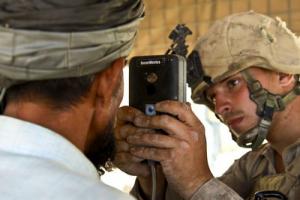RefugeesNew biometric measures to identify, track refugees
Refugees applying to come to the United States go through several different security measures aiming to make sure that they who they say they are, and that they are involved with terror organizations or criminal gangs. The security screening includes detailed interviews, three levels of background checks, three fingerprint screenings, contagious disease screening, and cultural orientation. The United States has plans in the works for additional biometric measures, including iris scanning and rapid-turnaround DNA testing.

Building a larger database for later access // Source: defense.gov
Refugees applying to come to the United States go through several different security measures aiming to make sure that they who they say they are, and that they are involved with terror organizations or criminal gangs. The security screening includes detailed interviews, three levels of background checks, three fingerprint screenings, contagious disease screening, and cultural orientation.
PBS reports that the United States has plans in the works for additional biometric measures in order to find out where and when refugees check into camps and offices. The use of these additional biometric measures also aims to deter fraud and more accurately confirm the identity of applicants for aid, services, or relocation.
DH will soon introduce iris scans, and the department is developing a quick turnaround DNA test which, in under ninety minutes, will be able to determine whether a refugees presenting themselves as members of a family are really related.
These new biometric measures are coming in at a time when the ongoing refugee crisis in Europe and last month’s deadly attack on Paris have prompted a debate over whether the United States should accept refugees from Syria.
More than two dozen GOP governors have said that they would try to block the resettlement of Syrian refugees in their states, and the House passed legislation which would require DHS secretary, the director of National Intelligence, and the director of the FBI each personally to sign off on the security clearances for every refugee from Syria or Iraq being accepted for entry into the United States.
The demand on the biometric scanners would be daunting. More than four million refugees have fled Iraq and Syria because of the fighting there. Many of the refugees flee their homes without papers, or lose documentation during their arduous journey, and thus can be difficult to identify and track.
UN agencies have been using fingerprinting techniques as the preferred method of identification, but this is time consuming and requires technical knowhow to interpret. In October 2013 the United Nations refugee agency adopted the use of iris scanners. The agency has since scanned the eyeballs of more than 1.6 million refugees in nations across the Middle East and Europe, with the exception of Turkey, which still insists on fingerprints.
The scanning has yielded a comprehensive biometric database of a large number of the refugees fleeing from Iraq and Syria. The refugees can be tracked as they check into the different camps in different countries.
“The great benefit is the ability to confirm identity without relying on pieces of plastic or paper,” Larry Yungk, a senior resettlement officer with the U.N., told PBS. “The scans are quick, painless, and require less technology and skill than you need for fingerprints.”
The United States does not use biometric scanners yet, but even before the Paris attacks there were already plans to upgrade from the fingerprinting. The United States is in contact with the UN over sharing the biometric refugee database with its State Department as well as Department of Homeland Security.
Another form of biometric testing the United States has been developing is the rapid DNA testing. The test would confirm the family relationship of refugees presenting themselves as members of the same family, but it is controversial. Refugee rights advocates say that the DNA test would not take into account the realities of refugee life, which includes the fact that some families take charge of children who have been separated from their parents or whose parents have lost their lives.
